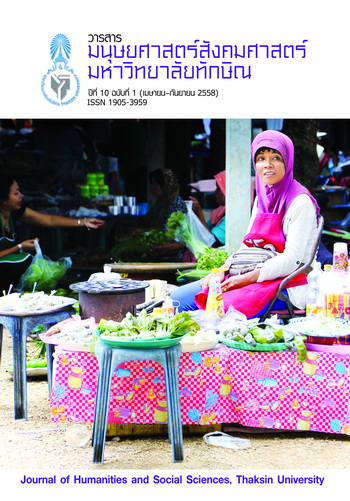แนวทางการฟื้นฟูการประกอบอาชีพหลังวิกฤติ นากุ้งของชาวบ้านอำเภอระโนดจังหวัดสงขลา
Main Article Content
บทคัดย่อ
งานวิจัยเรื่องนี้มีวัตถุประสงค์เพื่อศึกษาแนวทางการฟื้นฟูการประกอบอาชีพหลัง วิกฤติ นากุ้งของชาวบ้านอำเภอระโนด จังหวัดสงขลา โดยใช้วิธีวิจัยเชิงคุณภาพ ด้วย วิธีการสัมภาษณ์ แบบเจาะลึก การสังเกตแบบไม่มีส่วนร่วมและการสนทนากลุ่ม ซึ่งกลุ่ม ผู้ให้ข้อมูลได้แก่ ปราชญ์ชาวบ้าน นักวิชาการท้องถิ่น ผู้นำชุมชน และผู้เลี้ยงกุ้งจำนวน 27 คน นำข้อมูลที่ได้มาวิเคราะห์ตีความหาข้อสรุป และนำเสนอข้อมูลด้วยวิธีพรรณนา วิเคราะห์
ผลการศึกษาพบว่าแนวทางการฟื้นฟูการประกอบอาชีพ มี 6 แนวทางดังนี้ 1) การปรับเปลี่ยนวิธีการเลี้ยงกุ้งสำหรับผู้ที่ต้องการเลี้ยงกุ้งต่อไปโดยการลดต้นทุน การผลิต เช่น การเลี้ยงที่ต้องลดปริมาณยา และสารเคมี แต่เน้นเรื่องชีวภาพมากขึ้น หรือเปลี่ยนจากการเลี้ยงกุ้งกุลาดำมาเป็นกุ้งขาวที่ใช้ทุนน้อยกว่า เป็นต้น 2) ปรับ เปลี่ยนพื้นที่บ่อกุ้ง เป็นบ่อเลี้ยงปลา เช่น ปลานิล ปลากระบอก ซึ่งลดต้นทุนเรื่องอาหาร และการดูแลง่ายกว่า 3) ปรับเปลี่ยนพื้นที่เลี้ยงกุ้งมาปลูกพืชสวนครัวโดยมีการ ลงทุนปรับปรุงดินจากดินเค็มให้ดินมีคุณภาพดินดีขึ้น ใช้ปูนขาว ปุ๋ยคอก ซื้อหน้าดิน จากที่อื่นมาถมปรับพื้นที่แล้วปลูกพืชล้มลุกซึ่งรากไม่ลึก เช่น พริก มะเขือ แตงกวา ถั่ว ฯลฯ 4) ปรับพื้นที่เป็นไร่นาสวนผสม ทั้งนี้บ่อกุ้งเดิมใช้เลี้ยงปลานิล คันบ่อปรับคุณภาพ ดินปลูกพืชสวนครัว เช่น ตะไคร้ พริก มะเขือ และเลี้ยงสัตว์ผสมรอบๆ บ่อ เช่น เลี้ยง เป็ด เลี้ยงไก่ เลี้ยงวัว เป็นต้น แต่ไม่สามารถปลูกข้าวได้เพราะดินยังเค็ม 5) ปรับพื้นที่ บ่อกุ้งเป็นสวนปาล์มน้ำมัน โดยการถมบ่อกุ้งแล้วขุดร่องใหม่ทำแปลงปลูกปาล์มน้ำมัน ทั้งนี้จะต้องมีการปรับสภาพหน้าดินเสียก่อน 6) ปรับเปลี่ยนอาชีพจากการเลี้ยงกุ้ง ไปเป็นอาชีพอื่นๆ เช่น ค้าขาย หรือเปิดกิจการตัดเย็บเสื้อผ้าสำเร็จรูป เป็นต้น
The Guidelines of Restoration Vocational AfterThe Prawn Farming Crisis of the in Habitants At Ranote District, Songkhla Province
Jakkrit Juthathiprat1, Phaiboon Duangchan2, Nipon Tibsrinimit3 and Utit Sungkharat4
1Doctorate student Program in Cultural Studies, Thaksin University
2Associated Professor in Faculty of Humanities and Social Sciences, Thaksin University
3Assistant Professor Dr. in School of Liberal Arts, Walailak University
4Lecturer Dr. in Faculty of Liberal Arts, Prince of Songkla University, Hat Yai Campus
The objective of the study was to investigate the guidelines for earning restoration after the prawn farming crisis of the residents in Ranote District, Songkhla Province. The study was a qualitative study employing the following instruments to collect the data. They were in-depth interviews, a non-participant observation and a group conversation. The data were obtained from 27 people including local scholars, local academics, community leaders, and prawn farmers. The data were analyzed in order to present a descriptive analysis.
The result showed that there were 6 ways to restore earning: 1) change the way of prawn farming for those who still desired to continue their farms by reducing the cost of production such as reducing the use of drug and chemicals and emphasizing more on biological ways, or change from raising black tiger prawns to white prawns which had a lower cost , 2) change the prawn farm area to raise fishes such as tilapia, mullet, which could reduce the cost of food and is easier to manage, 3) change the prawn farm area to be a home-grown vegetable garden by using lime and manure to improve soil quality of alkaline soil or purchasing soil surface from other places to cover the area in order to grow annual crops with short roots such as chili, eggplants, cucumbers, and long beans, 4) improve the land for multiple purposes by farming tilapia in the old prawn farm and improving soil along the ridge for growing home-grown vegetables such as lemongrass, chili and, eggplants and raise many kinds of animals around the farm such as poultry and cows; however, rice cannot be grown because of alkaline soil, 5) convert the prawn farm to an oil palm garden by filling the prawn farm and prepare the plot for growing oil palm trees; however, the soil surface must be improved first and 6) change the career from being a prawn farmer to do another one such as a merchant or a tailor.


